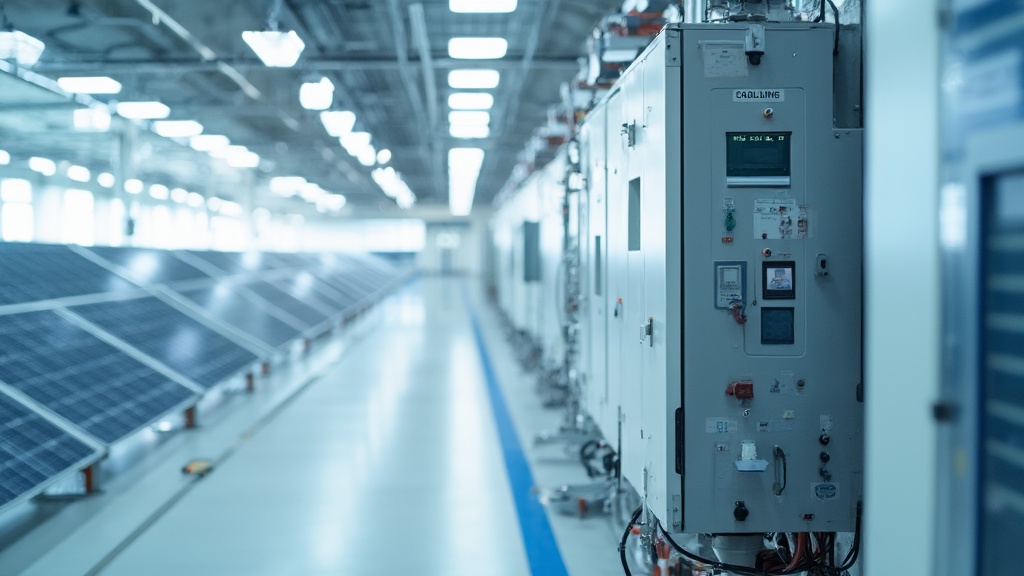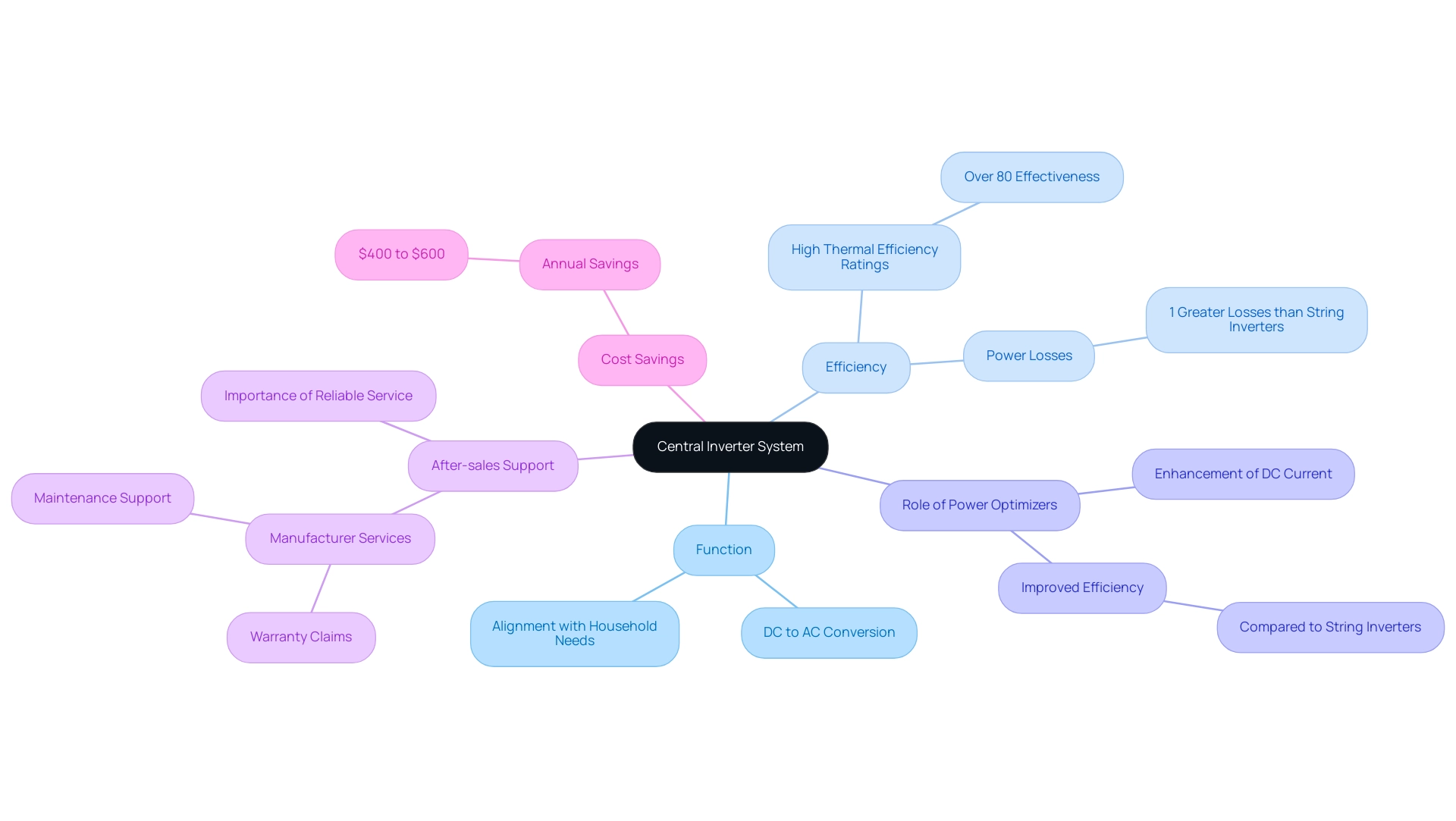Introduction
As homeowners increasingly turn to solar energy as a sustainable solution, understanding the technology behind it becomes essential. Central inverter systems serve as the backbone of these installations, converting solar-generated direct current (DC) into the alternating current (AC) that powers homes and businesses.
With the solar market booming and new advancements on the horizon, it’s important for homeowners to grasp the benefits and operational roles of these systems. From enhancing efficiency and reducing costs to navigating the choice between central inverters and microinverters, this article delves into the key factors that can empower homeowners to make informed decisions about their solar energy investments.
As the landscape of renewable energy continues to evolve, exploring how central inverters can optimize solar solutions will not only contribute to personal energy goals but also support a greener future for all.
Defining Central Inverter Systems in Solar Energy
A central inverter system is crucial for photovoltaic installations, acting as the primary hub that converts the direct current (DC) generated by photovoltaic panels into alternating current (AC), which is the form of electricity that powers our homes and businesses. These devices are especially prevalent in larger photovoltaic configurations, encompassing commercial uses and extensive residential systems. Comprehending the role of the central inverter system is essential for homeowners contemplating renewable power, as it plays a key part in enhancing the effectiveness of photovoltaic technology.
Recent insights indicate that the central PV converter market achieved a value of USD 11 billion in 2023 and is projected to expand at a CAGR of 10.2% through 2032, fueled by advancements in panel technology. Additionally, the Rest of Latin America Central Inverters market is projected to grow at a CAGR of 11.8%, indicating a broader trend worth noting for homeowners. Notably, in 2023, many chose to install batteries mainly for backup power rather than financial savings, underscoring the significance of resiliency in consumer decision-making concerning renewable power solutions.
This change highlights the essential function that a central inverter system serves in improving the overall efficiency of photovoltaic setups, positioning it as a crucial factor for environmentally aware homeowners. To further enhance photovoltaic systems, homeowners should also consider best practices for choosing panel converters, such as:
- Assessing converter efficiency
- Warranty
- Compatibility with existing photovoltaic technology
By understanding these factors, along with the implications of market growth, homeowners can make informed decisions that align with their resource needs and sustainability goals.
The Operational Role of Central Inverters in Solar Energy Systems
The central inverter system is a vital participant in the photovoltaic landscape, performing the important function of transforming the DC electricity produced by panels into AC electricity. This conversion is vital as it aligns with the power needs of most household appliances and the electrical grid, which predominantly operates on AC power. Not only does the central inverter system facilitate this transformation, but it also enhances the overall performance of the solar array, contributing to significant cost savings for eco-conscious homeowners.
For example, setups with high thermal efficiency ratings can achieve over 80% effectiveness, maximizing the output relative to input. Power optimizers play a significant role in this process by enhancing the DC current from each panel before it reaches the central converter, improving efficiency compared to string converters. By regulating energy output and ensuring that the central inverter system operates at optimal efficiency, central devices oversee panel performance and modify outputs as required—this function is essential in enhancing energy production and minimizing waste.
Furthermore, considering the manufacturer’s after-sales service is essential when selecting a photovoltaic inverter. Companies like Growatt provide prompt support for warranty claims and maintenance, ensuring that your energy investment remains functional over time. Additionally, homeowners can save between $400 to $600 annually on utility expenses by adopting heating systems powered by the sun, according to estimates from the Energy Department.
As emphasized by Gurdeep Singh, Chairman and Managing Director of NTPC Limited, ‘NTPC aims to become a leader in clean power transitions,’ highlighting the significance of enhancing sunlight-derived output through innovative technologies such as predictive analytics and artificial intelligence. Ultimately, a central inverter system not only facilitates the efficient use of renewable resources but also signifies a wise investment for homeowners aiming to improve their power solutions while aiding in the creation of a healthier planet.
Central Inverters vs. Microinverters: A Comparative Analysis
When exploring photovoltaic systems, you’ll usually encounter two primary varieties of converters: central inverter systems and micro converters. A central inverter system is frequently the preferred choice for larger installations, as it effectively consolidates the conversion of power from multiple panels into one unit, making it economical. However, microinverters stand out by being installed on each individual solar panel.
This unique setup allows them to optimize energy production on a panel-by-panel basis, which is particularly beneficial in scenarios where shading or panel orientation varies. For instance, the QT2 3-Phase Microinverter is designed for commercial applications, connecting to up to four PV modules while meeting rapid shutdown standards. This leads to enhanced performance and fewer points of failure compared to conventional string devices.
According to Enphase, a market leader in microtechnology, ‘With 50% of all lifetime solar maintenance expenses arising from string device failure, the reliability of micro devices is excellent for anyone aiming to lower the overall cost of their installation.’ Moreover, the scalability of power conversion units is improved by the Solis AC combiner Box, which can combine 2, 3, or 4 units, providing versatility for different installation sizes. Additionally, Tigo now supports generators up to 24 kW with its Automatic Transfer Switch, showcasing advancements in conversion technology that cater to larger systems.
When evaluating renewable power solutions, it’s also crucial to investigate how converters engage with photovoltaic batteries and other technologies, along with government initiatives that can help with installation expenses. Therefore, the decision between using a central inverter system and micro devices ultimately depends on the specific characteristics of your installation site and your personal energy goals, as well as the broader context of available resources and technologies.
Benefits of Central Inverter Systems for Solar Installations
Central inverter systems offer numerous benefits for homeowners contemplating renewable energy setups, especially those aiming to enhance efficiency and sustainability. For starters, they excel in cost-effectiveness, especially for larger setups. By minimizing the number of converters needed, homeowners can enjoy reduced installation and maintenance expenses, which is significant as electricity rates continue to rise.
Recent insights indicate that the residential segment is the fastest-growing end-user of photovoltaic technology, driven by government incentives such as the Investment Tax Credit (ITC) and the increasing need for efficient power solutions. In addition to cost savings, the central inverter system simplifies monitoring and maintenance as it functions as a single unit. This centralized method not only simplifies maintenance but also improves performance monitoring, enabling homeowners to monitor their output effortlessly.
The scalability of the central inverter system allows for simple growth of photovoltaic installations, meeting future power requirements without significant modifications.
Durability is another essential aspect; the central inverter system typically endures longer than micro units, making it a wise investment for the long term. The U.S. market for photovoltaic energy is projected to surpass USD 4.6 billion by 2034, thanks to supportive government policies and a growing preference for decentralized energy solutions. As the Middle East and Africa Central Devices market is anticipated to produce sales revenue of $270.24 million in 2024, with a CAGR of 13% from 2024 to 2031, the global significance and growth potential of central energy solutions cannot be ignored.
For Long Beach renters and eco-conscious homeowners, comprehending these technologies’ economic and environmental advantages is essential. Numerous commercial and industrial sectors have already capitalized on the benefits of the central inverter system, which effectively manages large-scale photovoltaic setups. This real-world application illustrates the impressive cost savings and operational benefits achievable in residential settings as well.
Furthermore, local government initiatives offer incentives for tenants to utilize renewable solutions, facilitating the adoption of environmentally friendly alternatives. As we look forward to 2024, the ongoing progress and popularity of central inverter systems indicate a promising future for homeowners keen to adopt renewable energy, creating a favorable moment to investigate choices like Tesla home chargers and energy storage solutions. Furthermore, evaluating top solar batteries will ensure homeowners select the most efficient storage solutions for their needs.
The Future of Central Inverter Technology in Solar Energy
The future of the central inverter system for energy conversion technology is indeed promising, with exciting advancements on the horizon that aim to enhance efficiency and functionality for homeowners. Among the most notable innovations are intelligent devices, which significantly enhance grid integration. These advancements facilitate improved power flow management and enhance compatibility with renewable sources, making solar setups more effective than ever.
According to Cognitive Market Research, the on-grid segment commands the largest share in the global central inverter system market, underscoring the importance of these technologies. In fact, the central inverter system market is projected to grow at a remarkable CAGR of 11.8% during the forecast period, highlighting the significance of ongoing advancements. Imagine a system that not only captures the sun’s power but also intelligently adapts to fluctuations in power production!
With the incorporation of artificial intelligence and machine learning, these intelligent devices will forecast power outputs and modify configurations in real time, ensuring optimal performance. As these technologies evolve, the central inverter system is set to become even more efficient and user-friendly. This evolution not only reinforces their pivotal role in residential installations but also enhances the appeal of renewable power for eco-conscious homeowners seeking sustainable solutions.
To effectively utilize sunlight, homeowners should comprehend how photovoltaic panels function. A fundamental step-by-step manual involves:
- Evaluating your power requirements
- Choosing the appropriate panel type
- Identifying the optimal battery options to enhance your setup
Additionally, understanding market segmentation—encompassing nominal output voltage, nominal output power, and phase—will be crucial for homeowners in selecting the right solar energy systems tailored to their needs.
Conclusion
Understanding central inverter systems is vital for homeowners looking to invest in solar energy. These systems play a crucial role in converting the direct current generated by solar panels into the alternating current that powers homes, making them essential for maximizing energy efficiency. The advantages of central inverters, including cost-effectiveness, simplified maintenance, and scalability, position them as an ideal choice for larger solar installations. As the market continues to grow, homeowners can benefit from emerging technologies that enhance the performance and longevity of these systems.
The comparison between central inverters and microinverters highlights the importance of evaluating specific installation needs. While central inverters are generally more suitable for larger setups, microinverters offer unique advantages in optimizing energy production on an individual panel basis. This choice ultimately depends on factors such as shading, panel orientation, and overall energy goals.
Looking ahead, advancements in central inverter technology, including the integration of smart features, promise to revolutionize the way solar systems operate. As these innovations unfold, they will further enhance the efficiency and user-friendliness of solar energy solutions, making them even more appealing to eco-conscious homeowners. By staying informed about these developments and understanding the operational roles of central inverters, homeowners can make empowered decisions that not only meet their energy needs but also contribute to a sustainable future.



